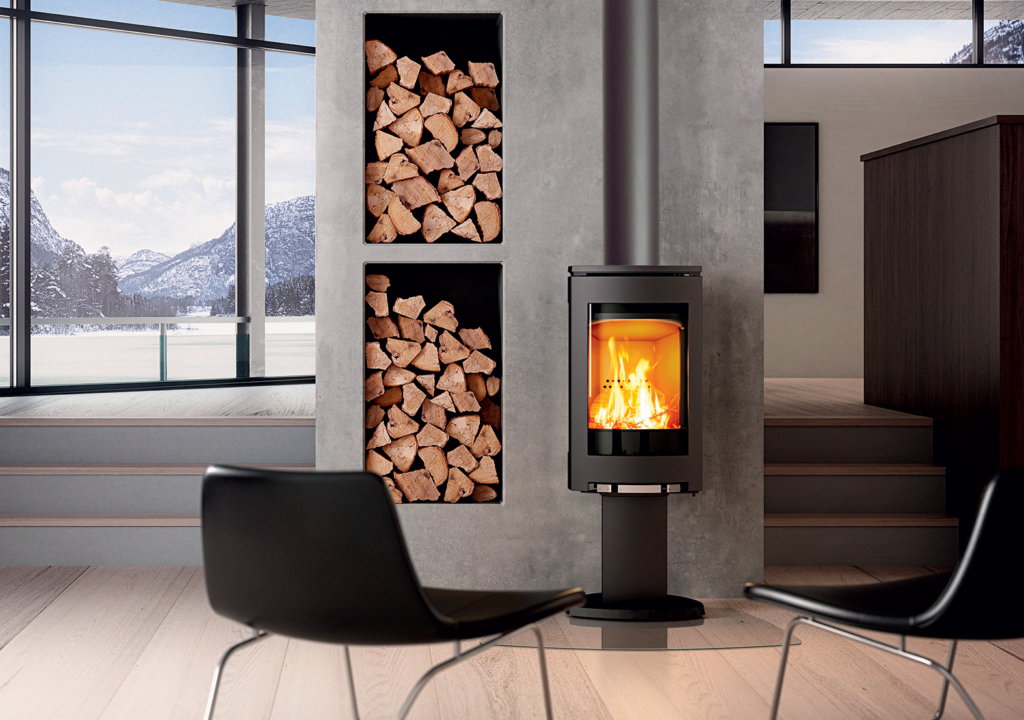
Early Bird Offer! Free tickets to meet independent experts at this summer's Build It Live
Save £24 - Book Now!
Early Bird Offer! Free tickets to meet independent experts at this summer's Build It Live
Save £24 - Book Now!Wood-fuelled stoves burn logs, wood chips or wood pellets for fuel, and heat water using an integral boiler or are connected to a separate boiler to provide hot water and heat. The hot water is drawn off and kept in a well-insulated storage tank. They became popular in the UK in the seventies, when oil prices increased and stoves were imported from Europe.
Modern stoves have come along way – many are easy to fire up by simply pressing a button, often with an automated fuel feed so you don’t have to keep stoking, and with many designs you’ll only need to clear the ash once a month. An efficient stove will make very little ash, and you can use this as a fertiliser in the garden.
Logs suitable for domestic boilers are generally from fast-growing willow or poplar in coppiced woodlands, or from ash, which burns green and has a low moisture content. The most suitable hardwoods are those with a high calorific value such as beech and birch.
Wood chips are suited to large, non domestic-sized wood boilers. Best for domestic use are small pellets, 8-10mm in diameter. These are made from compressed sawdust and wood shreds, the waste products from sawmills or manufacturing. Compact, dense and with a low moisture content, they are ideal for automated feeding via a hopper into small-output domestic boilers – up to about 50kW output – because they are ‘flowable’. They also produce less smoke and ash than logs.
A streamlined pellet-burning stove, such as the Olivieri, is highly efficient, working at around 85-90 per cent efficiency and burning for up to 40 hours at a stretch. Self lighting, it can turn itself off and be programmed to go off and on just like a gas boiler. You can even tell it to light from your mobile phone when you are driving home.
The carbon dioxide given out when wood is burned is equal to that which was absorbed from the atmosphere while the tree was growing, and is the CO2 that would be released naturally as the dead tree decays.
Even allowing for emissions of fossil carbon dioxide in comparison to planting, harvesting, processing and transporting wood fuel, it will typically reduce net CO2 emissions by over 90 per cent, and there is also virtually no sulphur produced.
To be truly eco-friendly, the wood must come from a sustainable source where the trees are replaced once felled, or from coppiced woodland where the tree roots are left in the ground to grow again.
Read more: Is your woodburning stove eco friendly?

The F163 Woodburning Stove by Jotul
A log boiler costs about £1,000-£2,000, a basic water storage tank about £200-300. Also allow for flue and installation costs. Automated pellet boiler stoves cost £3,000-£4,000, plus installation. Wood boiler prices are likely to fall as more people take up this option in the UK, and you may eligible for a £1,500 grant.
Check that the boiler you choose has accessible and reliable servicing back-up. If you don’t have your own supply of fuel, make sure you can get a good local supply of logs or pellets. You also need storage to keep fuel dry and allow logs to season for up to two years so the moisture content is below 23 per cent.
Pellets take up far less space and have a moisture content of only about 8 per cent. A 15kg bag of pellets costs £3-£4, more if it has to be transported far, and should last for several days of continuous burning.
Wood can be burned in a smokeless zone if the appliance (the stove or boiler) has an exemption certificate – try Clearview, Vermont Castings, Dovre, Dunsley Yorkshire Stoves, Morso and Jotul for suitable models. At present, there are no pelletburning stoves or boilers on the UK exemption list.


Comments are closed.